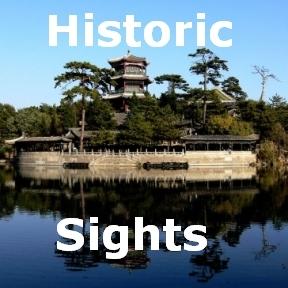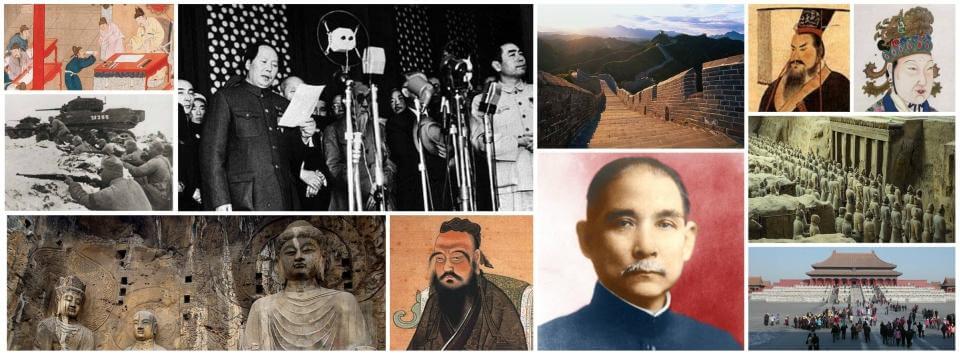
Chengde Mountain Resort
The information contained here are subject to change. Chinese History Digest is not responsible or liable if any changes should occur.
Opening Hours
April: 7.30am - 5.30pm
May - October 9th: 7am - 6pm
October 10th - March: 8am - 5.30pm
Entrance Ticket Prices
April - October: 130 yuan
November - March: 90 yuan
Free for children under 1.2m
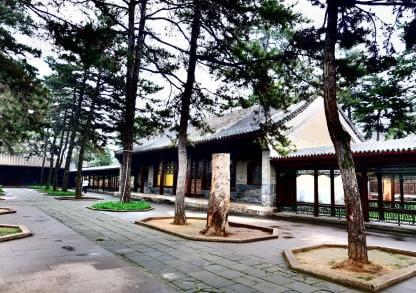 the buildings of the Chengde Summer Villa are set among treesThe Chengde Mountain Resort is located just north of the city center of Chengde in Hebei province. The resort is also known under a variety of other names such as Chengde Summer Palace, Chengde Summer Villa, Rehe Temporary Palace or Rehe Imperial Palace. Chinese people generally refer to it as Bishu Shanzhuang (Mountain Manor for Escaping the Summer Heat) or Ligong (Li Palace).
the buildings of the Chengde Summer Villa are set among treesThe Chengde Mountain Resort is located just north of the city center of Chengde in Hebei province. The resort is also known under a variety of other names such as Chengde Summer Palace, Chengde Summer Villa, Rehe Temporary Palace or Rehe Imperial Palace. Chinese people generally refer to it as Bishu Shanzhuang (Mountain Manor for Escaping the Summer Heat) or Ligong (Li Palace).
As a UNESCO World Heritage site, the Chengde Mountain Resort is a must-see attraction for everyone interested in Chinese culture and history. Travelers that are not pressed for time might consider scheduling more than just a single day to visit this historic sight. That is most convenient to do when staying overnight at the Qiwanglou Hotel which is more commonly referred to as the Chengde Imperial Mountain Resort. This comfy hotel is located near the Summer Palace's main entrance gate and you can read our review of its services and amenities at the bottom of this page!
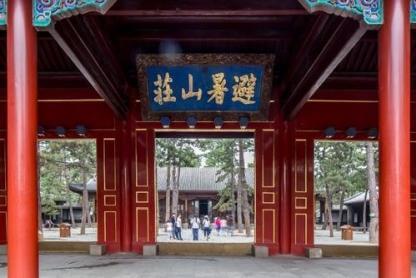 Palace Area halls inside the Chengde Summer PalaceConstruction of the Chengde Mountain Resort took about 90 years and went on from 1703 until 1792 during the time of the Qing Dynasty. It occupies a huge area of about 5.64 square kilometers and is surrounded by an outer wall of about 10km in length. The resort was built as a summer hangout for the Qing imperial family away from Beijing's often unbearable summer heat and humidity. Chengde's pleasant climate and appealing natural scenery made it an ideal spot for this purpose.
Palace Area halls inside the Chengde Summer PalaceConstruction of the Chengde Mountain Resort took about 90 years and went on from 1703 until 1792 during the time of the Qing Dynasty. It occupies a huge area of about 5.64 square kilometers and is surrounded by an outer wall of about 10km in length. The resort was built as a summer hangout for the Qing imperial family away from Beijing's often unbearable summer heat and humidity. Chengde's pleasant climate and appealing natural scenery made it an ideal spot for this purpose.
Bishu Shanzhuang can also be regarded as the largest imperial garden in China. More than 120 groups of buildings are dispersed throughout its vast area. In them, you will find many types of classical Chinese architecture such as grand halls, pagodas, pavilions, courtyards and temples. Many building compounds bear poetic names in Chinese, some of which you will find mentioned further below on this webpage in the descriptions of the various areas of the resort.
With a landscape that is characterized by waterways at the southeast, a mountainous area at the northwest and a plain area at the center, the overall layout of the Chengde Mountain Resort mirrors the general landscape of China as a whole. Many of the most outstanding architectural structures are located along the shores of one of the eight lakes that give the resort's southeastern area the appearance of a Jiangnan-style classical garden.
The vast area of the Chengde Mountain Resort is divided into the following four parts:
- Palace Area
- Lake Area
- Plain Area
- Mountain Area
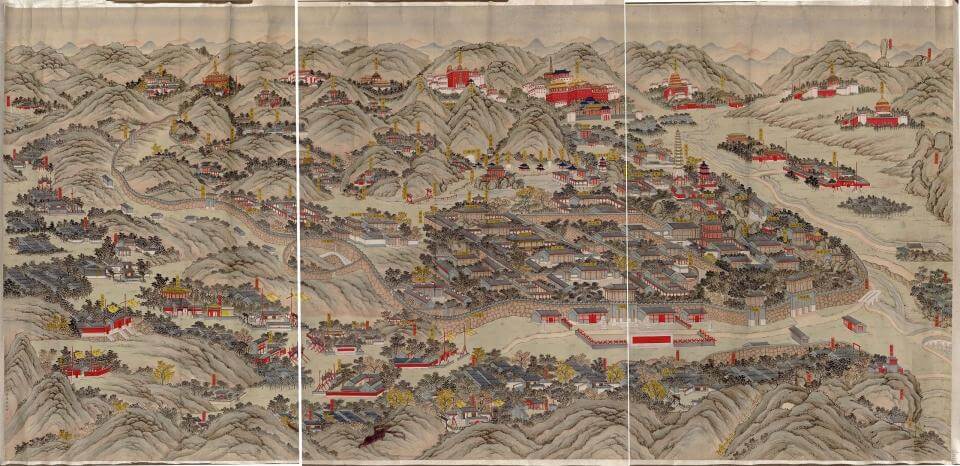 historic map of the territory of the Chengde Mountain Resort
historic map of the territory of the Chengde Mountain Resort
1. Palace Area
After entering the Chengde Mountain Resort through the Lizheng Gate in the south, tourists will come to the Palace Area. It covers an area of about 100,000 square meters and consists of nine courtyards. This is where the Qing imperial family lived and where the emperors handled their political affairs during their summers (May - September) in Chengde. The buildings here are austere in style with relatively simple furnishings. The roofs of the main halls are covered by green-glazed tiles and their foundations resemble those of ordinary houses. Tall pine trees surround the buildings which gives the entire area an air of tranquility.
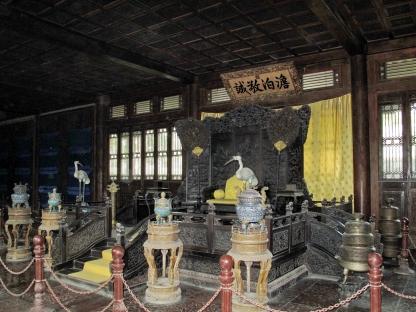 the emperor's throne inside the Danbo Jingcheng HallThe four palatial complexes in the Palace Area are the Main Palace, Wanhesongfeng Hall (Pine Soughing Valley), Pine-Crane Hall and East Palace. The Main Palace nowadays serves as the Mountain Resort Museum and stores and displays about 30,000 cultural relics, including 28,400 historical texts, 21 important inscriptions and various items that were once used by the emperors. The southern part of the Main Palace is the former court area and the northern part is where the emperors lived. Before reaching the main hall of the palace, visitors had to pass through the Lizheng Gate, Outer Meridian Gate and Inner Meridian Gate. Two bronze lions stand before the Inner Meridian Gate which is famous for the horizontal tablet that bears the Kangxi Emperor's calligraphic inscription Bishu Shanzhuang (Mountain Manor for Escaping the Summer Heat).
the emperor's throne inside the Danbo Jingcheng HallThe four palatial complexes in the Palace Area are the Main Palace, Wanhesongfeng Hall (Pine Soughing Valley), Pine-Crane Hall and East Palace. The Main Palace nowadays serves as the Mountain Resort Museum and stores and displays about 30,000 cultural relics, including 28,400 historical texts, 21 important inscriptions and various items that were once used by the emperors. The southern part of the Main Palace is the former court area and the northern part is where the emperors lived. Before reaching the main hall of the palace, visitors had to pass through the Lizheng Gate, Outer Meridian Gate and Inner Meridian Gate. Two bronze lions stand before the Inner Meridian Gate which is famous for the horizontal tablet that bears the Kangxi Emperor's calligraphic inscription Bishu Shanzhuang (Mountain Manor for Escaping the Summer Heat).
The main hall of the palace that stands behind the Inner Meridian Gate is known as the Danbo Jingcheng Hall (Hall of Frugality and Placidity). It was entirely built of Nanmu wood which gives off a peculiar scent that repels mosquitoes. The Qing emperors held important ceremonies and events at this hall such as the reception of foreign envoys, court officials and nobles of various minority ethnic groups. Before and after ceremonies, the emperor would rest at the "Great Hall by the Lake" (Yihukuangdian) behind the Danbo Jingcheng Hall and only his most trusted court officials would have access to him there.
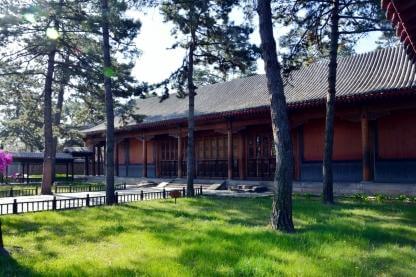 outside view of the Yanbo Zhishuang Hall, the emperor's living quartersThe Yanbo Zhishuang Hall (Hall of Refreshing Mists and Waves) is the main hall of the emperor's living quarters at the rear of the Main Palace. In this hall, a concealed door just behind the emperor's bed allowed him to escape in times of danger. The two emperors that died (peacefully) inside the Yanbo Zhishuang Hall were the Jiaqing Emperor (in 1820) and the Xianfeng Emperor (in 1861). While the Kangxi Emperor lived inside this hall for 12 summers during the course of his reign, the Qianlong Emperor even spent 52 summers here. It was also these two emperors that each named half of the 72 scenic spots that are dispersed throughout the entire Chengde Mountain Resort.
outside view of the Yanbo Zhishuang Hall, the emperor's living quartersThe Yanbo Zhishuang Hall (Hall of Refreshing Mists and Waves) is the main hall of the emperor's living quarters at the rear of the Main Palace. In this hall, a concealed door just behind the emperor's bed allowed him to escape in times of danger. The two emperors that died (peacefully) inside the Yanbo Zhishuang Hall were the Jiaqing Emperor (in 1820) and the Xianfeng Emperor (in 1861). While the Kangxi Emperor lived inside this hall for 12 summers during the course of his reign, the Qianlong Emperor even spent 52 summers here. It was also these two emperors that each named half of the 72 scenic spots that are dispersed throughout the entire Chengde Mountain Resort.
The Wanhesongfeng Hall ("Pine Soughing Valley" or more poetically the "Hall of the Wind in the Pines of Ten Thousand River Valleys") to the northeast of the Main Palace was the place where the emperors came to read books and memorials. The Kangxi Emperor also used this hall to receive officials. He often brought his favourite grandson (who became the Qianlong Emperor) with him who remembered these study and reading sessions fondly later on in his life.
The Pine-Crane Hall to the east of the Main Palace was built by the Qianlong Emperor for his empress-mother. Empress Dowager Cixi also used this part of the Chengde Summer Palace as her living quarters in later years. The East Palace was another place where the emperors once handled their daily court affairs and received foreign envoys as well as nobles of various minority ethnic groups. Unfortunately, it was completely devastated by a fire in 1945 and only its foundations remain visible today.
2. Lake Area
The Lake Area is located to the north and east of the Palace Area. It originally consisted of nine lakes which were dotted with ten islands (five small islets and five bigger islands). The nine lakes were named Cheng Lake, Mirror Lake, Ruyi Lake, Upper Lake, Lower Lake, Silver Lake, Half-Moon Lake, Inner Lake and Long Lake. Eight lakes remain and the most convenient way to get around them is by electric boat (90 yuan per person). The boat makes several stops at the lakeshore near some of the area's most popular sights. It is however also possible to walk to the most famous attractions. Bridges connect the bigger islands to the lakeshore and sandbars, dykes and bridges interlink many of the Lake Area's islands.
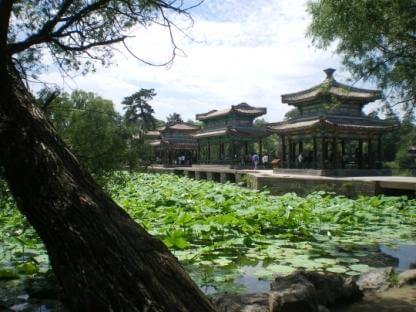 Shuixin Pavilions at the Lake Area of the Chengde Summer PalaceOf the Mountain Resort's 72 famous scenic spots that were named by the Kangxi and Qianlong emperors, 31 are located within the Lake Area. The landscape and traditional Chinese architecture in this area recreate typical scenic views that can be seen south of the Yangtze River such as the West Lake scenery of Hangzhou.
Shuixin Pavilions at the Lake Area of the Chengde Summer PalaceOf the Mountain Resort's 72 famous scenic spots that were named by the Kangxi and Qianlong emperors, 31 are located within the Lake Area. The landscape and traditional Chinese architecture in this area recreate typical scenic views that can be seen south of the Yangtze River such as the West Lake scenery of Hangzhou.
The Shuixin Pavilions (Water Heart Pavilions) are located to the northeast of the Palace Area. The three pavilions that were built in 1709 stand between two traditional archways on top of the bridge that spans across Silver Lake. The five buildings appear to be floating on the water when photographed from a distance. The view from the top of the bridge is also spectacular with the Palace Area in sight nearby, green hills in the distance and blue waters dotted with water lotus flowers underneath.
A group of buildings can be seen amidst ancient pine trees on a flat island to the north from here. This "Island for Enjoying the Sound of the Water under the Moonlight" was the place where the emperors came to read, listen to music and even fish. The buildings of this recreational retreat are arranged in the traditional courtyard style of northern China. Roofed corridors connect the halls and an artificial hill that is made of stones stands in the middle of the square courtyard.
After having crossed the Shuixin Pavilions bridge from south to north, visitors can continue walking straight to reach the Jinshan Mountain (Golden Mountain), the highest point in the Lake Area. As one of the main attractions of the Chengde Mountain Resort, it was built to resemble the Jinshan Hill and Temple in Zhenjiang (Jiangsu province). The view of Jinshan Mountain is dominated by the three-storey hexagonal "Pagoda of the Supreme Emperor" which stands at its peak. After climbing to the upper level of this building that was originally dedicated to two Taoist deities, visitors will be able to overlook the entire Lake Area. The tall pagoda is surrounded on the hillside by two traditional halls and a few smaller pavilions. The building complex stands in the shadows of tall pine and cypress trees and is poetically named Tianyu Xianchang ("All Under a Wide Sky in Harmony"). On the south side of Jinshan Mountain, stone steps lead down to the edge of Chenghu Lake.
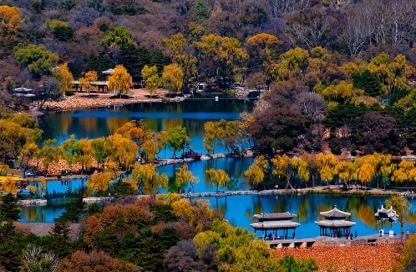 partial overview of the Chengde Mountain Resort's Lake Area in autumnWhen walking further north from Jinshan Mountain through an ancient pine forest, visitors will reach Xiang Yuan Yi Qing, a reconstructed garden area with small ponds and creeks. The Rehe Spring (Warm Spring) is located further north from there at the northeast corner of the Lake Area. This natural spring is the main source of water for the eight lakes in the Lake Area. Even in the midst of winter when the surrounding area is covered with thick snow, Rehe Spring never freezes. Its average temperature is about 8 degrees Celsius in winter. As the water gushes out of the ground, it forms the Rehe River which is the shortest river in China that runs for only about 700 meters before flowing into Chenghu Lake.
partial overview of the Chengde Mountain Resort's Lake Area in autumnWhen walking further north from Jinshan Mountain through an ancient pine forest, visitors will reach Xiang Yuan Yi Qing, a reconstructed garden area with small ponds and creeks. The Rehe Spring (Warm Spring) is located further north from there at the northeast corner of the Lake Area. This natural spring is the main source of water for the eight lakes in the Lake Area. Even in the midst of winter when the surrounding area is covered with thick snow, Rehe Spring never freezes. Its average temperature is about 8 degrees Celsius in winter. As the water gushes out of the ground, it forms the Rehe River which is the shortest river in China that runs for only about 700 meters before flowing into Chenghu Lake.
Qinglian Island (Green Lotus Island) is a small island in Chenghu Lake that can be seen to the southwest of Rehe Spring. The blue-tiled Yanyu Tower (Tower of Mist and Rain) that the Qianlong Emperor had built here in 1780 is an imitation of the Yanyu Tower at the Jiaxing South Lake (Zhejiang province). One of the rooms inside this large building that is supported by red pillars was the Study and Reading Room of the emperor. The large calligraphy plaque that reads Yanyulou in the middle of the upper floor was inscribed by none other than the Qianlong Emperor himself! From the top of Yanyu Tower, you can overlook the enchanting scenery of lakes and spot Yongyou Temple in the Plain Area to the north.
Ruyizhou is an area with halls, temples and pavilions with southern Jiangnan-style gardens and courtyards. Of the abovementioned 72 scenic spots, 12 are located inside this relatively small area (of about 35,000 square meters) of the Chengde Mountain Resort! Another Jiangnan-style garden area is the Wenyuan Lion Forest whose creation was inspired by the Lion Grove Garden (Shizilin) in Suzhou (Jiangsu province).
3. Plain Area
The Plain Area is located just north of the Lake Area. The topography of this part of the Chengde Mountain Resort is characterized by grassland and woods with tall old trees. The Qing emperors used this part of the resort as a leisure area where they could have large banquets, practice archery and ride horses. Back then, there were still wild animals roaming around in this area such as hares and flocks of elk so the emperor and his court officials could go on hunts.
Just like the emperor and his court officials in times of old, adventurous tourists nowadays also have the opportunity to rent a horse and ride over the grassland in the western part of the Plain Area. The eastern part of the Plain Area north of the Rehe Spring is the Wanshu Garden (Garden of Ten Thousand Trees). This area can be described as a park with grassland and many tall trees. It is said that 28 Mongolian yurts once stood here and replicas of such yurts have been erected to give tourists an impression of the past.
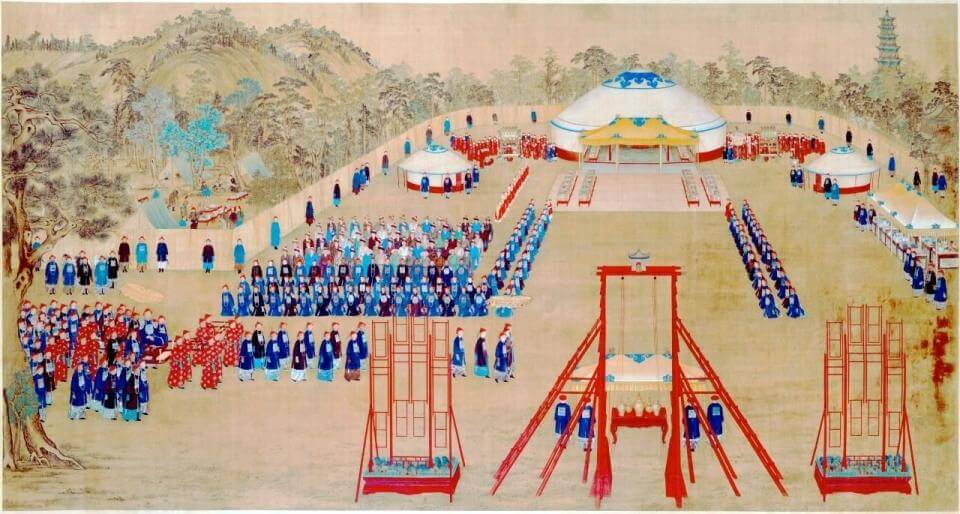 Giuseppe Castiglione's painting "Imperial Banquet in the Garden of Ten Thousand Trees"
Giuseppe Castiglione's painting "Imperial Banquet in the Garden of Ten Thousand Trees"
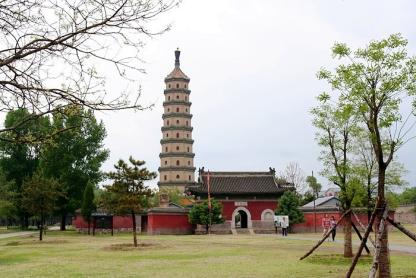 view of the entrance gate of the Yongyou Temple and the Yongyousi PagodaThe largest yurt measured 24 meters in diameter and served as a temporary palace for the emperor. One of the important events that took place there was a lavish banquet in 1754 that has been immortalized in Giuseppe Castiglione's painting "Imperial Banquet in the Garden of Ten Thousand Trees". That famous banquet served to strengthen the allegiance of the Derbet Mongols to the Qing empire and it is believed to have lasted for 10 days!
view of the entrance gate of the Yongyou Temple and the Yongyousi PagodaThe largest yurt measured 24 meters in diameter and served as a temporary palace for the emperor. One of the important events that took place there was a lavish banquet in 1754 that has been immortalized in Giuseppe Castiglione's painting "Imperial Banquet in the Garden of Ten Thousand Trees". That famous banquet served to strengthen the allegiance of the Derbet Mongols to the Qing empire and it is believed to have lasted for 10 days!
At the northern part of the Plain Area just north of the Wanshu Garden lies the Yongyou Temple (Temple of Eternal Blessing). This Buddhist temple was built in 1751 during the reign of the Qianlong Emperor. Besides worshiping Buddhist deities, the Qing emperors also visited this temple in order to venerate the spirits of their ancestors. The overall layout and design of the Yongyou Temple were modeled after the Grand Bao'en Temple in Nanjing. The towering Yongyousi Pagoda however was built to resemble the Liuhe Pagoda in Hangzhou. It has an octagonal base and its nine storeys reach about 70 meters up into the sky, making it the tallest building at the Chengde Mountain Resort and one of the tallest pagodas in all of China!
The buildings to the west of the Wanshu Garden are known as the Wenjin Pavilion (Literary Nourishment Pavilion). This former imperial library was built in 1773 and once stored a collection of 10,000 volumes, including one of only seven copies of the Siku Quanshu (Complete Collection of Four Treasures). Three of the six other copies of this handwritten collection of historic Chinese texts were stored for the exclusive use of the emperor at libraries inside the Forbidden City, Old Summer Palace and the Shenyang Imperial Palace.
4. Mountain Area
The northwestern part of the Chengde Mountain Resort is the Mountain Area. It is the largest of the four areas and occupies about eighty percent of the resort's surface. Five deep and narrow valleys cut through the forested hills here that rise up to 180 meters above the surrounding lakes and plains. Small streams that are formed by natural springs run through the valleys and tall pine trees provide refuge to various kinds of birds. The emperors once used the Mountain Area of the resort for hunting. Nowadays, there are still many deer roaming around here and they are not at all shy about coming in contact with humans!
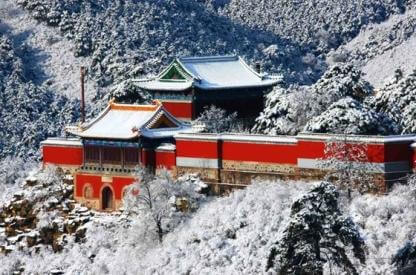 view of the Taoist Guangyuan Palace Temple in winterThere used to be 44 scenic spots with pavilions and small temples throughout the Mountain Area but most of them are now either dilapidated or have fallen into complete ruin. Of the four hilltop pavilions that once existed, only the Snow-Capped Southern Mountain Pavilion (Nanshanjixue) has survived the times. From the pavilion, visitors will enjoy perfect views of the nearby Yongyousi Pagoda in the Plain Area.
view of the Taoist Guangyuan Palace Temple in winterThere used to be 44 scenic spots with pavilions and small temples throughout the Mountain Area but most of them are now either dilapidated or have fallen into complete ruin. Of the four hilltop pavilions that once existed, only the Snow-Capped Southern Mountain Pavilion (Nanshanjixue) has survived the times. From the pavilion, visitors will enjoy perfect views of the nearby Yongyousi Pagoda in the Plain Area.
While it is possible to explore the Mountain Area of the Chengde Mountain Resort on foot, there are also battery-powered tour vehicles that drive through here while making several stops along the way. The Songyun Gorge (Pine Cloud Gorge) is the northernmost of the area's four valleys. Most temples and pavilions that once stood here now lie in ruins. The Guangyuan Palace is still in good condition though. This Taoist temple was modeled after the Bixia Temple on Mount Tai. Its red walls and green tiles make it stand out when seen through the foliage from a distance. The temple is located near the northern wall of the resort. A ramp leads up to the top of this wall which gives tourists access to the walkway at its center. From here, tourists will be able to take splendid panorama pictures of the Putuo Zongcheng Temple and the Xumi Fushou Temple when the weather is good. The red walls of these two huge temples can be seen to the north and northeast in this 360-degree photo that is available on Google Street View!
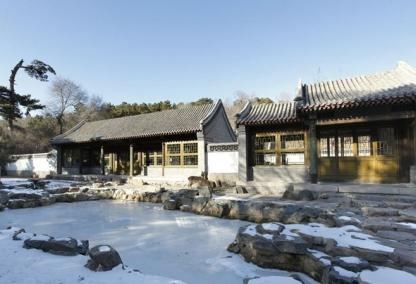 buildings at the "Pine and Crane at Qingyue" complexThe Fanghe Pavilion stands to the north of the Lishu Gorge (Pear Tree Gorge) near the northwestern corner of the resort. The smallest valley - West Valley - branches off near here to the south and the "Pavilion Surrounded by Cloud-Covered Mountains" that can be seen on top of Mount Simianyun is the highest-located pavilion in the entire resort. The far-reaching views from this pavilion are relatively easy to come by since this is one of the stops of the tourist vehicles that drive through the resort's Mountain Area.
buildings at the "Pine and Crane at Qingyue" complexThe Fanghe Pavilion stands to the north of the Lishu Gorge (Pear Tree Gorge) near the northwestern corner of the resort. The smallest valley - West Valley - branches off near here to the south and the "Pavilion Surrounded by Cloud-Covered Mountains" that can be seen on top of Mount Simianyun is the highest-located pavilion in the entire resort. The far-reaching views from this pavilion are relatively easy to come by since this is one of the stops of the tourist vehicles that drive through the resort's Mountain Area.
The Songlin Gorge (Pine Forest Gorge) and Hazelnut Gorge (Zhenzi Gorge) are two smaller valleys that are located to the west of the Lake Area and north of the Palace Area. The "Pavilion of the Hammer Peak in the Glow of the Setting Sun" stands on the west face of the mountain that separates these two valleys. It was erected by the Kangxi Emperor who enjoyed watching the sunset from there. This emperor was also responsible for the construction of the relatively plain-looking residential complex "Pine and Crane at Qingyue" to the south of the mountain at the meeting point of the two valleys. Originally built for the empress, the Qianlong Emperor (the Kangxi Emperor's favourite grandson) later used it as a study.
After having visited all four areas of the Chengde Mountain Resort, tourists might consider staying in Chengde for at least another day to check out the Outlying Temples. These twelve Buddhist temples are inscribed on the UNESCO World Heritage list as well. They were built in succession between 1713 and 1780, each temple in a different architectural style. This highly-detailed map of Chengde depicts both the Outlying Temples as well as the vast territory of the Chengde Mountain Resort!
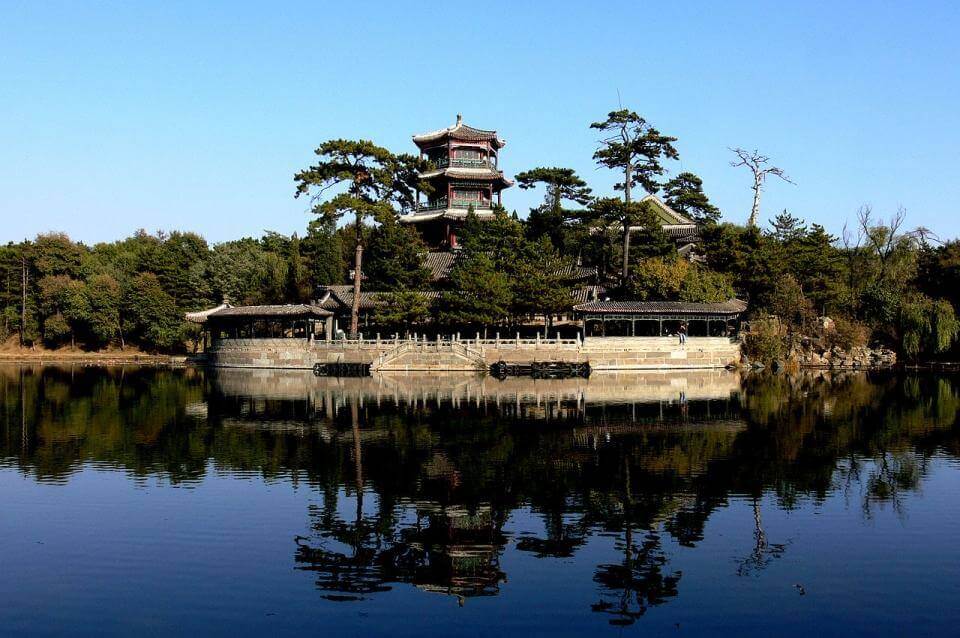 view of the Jinshan Mountain (Golden Mountain) at the Chengde Mountain Resort
view of the Jinshan Mountain (Golden Mountain) at the Chengde Mountain Resort
How to get to the Chengde Summer Palace?
| Address: | Chengde Summer Palace, Shuangqiao district, Chengde, Hebei province, China |
| Tel.Nr.: | +86 314 202 9771 |
| Airport: | Chengde Puning Airport (CDE) |
| Train Station: | Chengde Railway Station or Chengde South Railway Station, Chengde East Railway Station |
| Bus: | Bishu Shanzhuang Station (bus lines: 1, 5, 6, 11, 15, 16, 17, 28, 29, 30, 228); bus lines 5, 15, 29 from the Chengde Railway Station |
On the following Google map, you can see the location of the Chengde Mountain Resort (the blue icon) and our recommended hotel nearby, the Chengde Imperial Mountain Resort (the yellow hotel bed icon). Further below on this page, you can read a review of this hotel's services and amenities. In case you are planning a trip to China, you could support this website by using the provided affiliate links to check prices and book your hotel accommodation!
You can book hotels in China with both of our affiliate partners Agoda and Trip.com. No matter whether you choose Agoda or Trip.com, you will find many offers on each of these platforms that will allow you to make a risk-free booking with the possibility of free cancellation until a clearly stated date and time, sometimes as late as the intended date of arrival. However, some deals require prepayment and don't permit cancellation without fees. In that case, the incurred cancellation fees are clearly stated.
When following an Agoda link, the search results will show you prices, availability and special offers for your chosen dates with the recommended hotel in the top search position as well as for other hotels in the same area. Links to Trip.com will take you to the specific hotel webpage where you can then search for availability, prices and special deals with your chosen dates.
The provided information was thoroughly researched from various hotel booking websites. Chinese History Digest is not responsible if any information regarding the provided services and amenities might have changed.
Recommended Hotel near the Chengde Mountain Resort
The Chengde Imperial Mountain Resort that is reviewed below is located right next to the Chengde Summer Palace. In addition to the links to Agoda that are used in the review below, this hotel is also available for booking on Trip.com by following this link.
Chengde Imperial Mountain Resort
 Even though the Chengde Imperial Mountain Resort is officially 'only' a 3-star hotel, it is widely regarded as the best hotel in Chengde. It can look back upon quite a distinguished history during which it was frequently visited by foreign heads of state as well as Chinese party leaders. Already having been rebuilt in 1984, the Chengde Imperial Mountain Resort was completely renovated in 2011/12. Furthermore, the hotel's location can only be described as perfect since both the entrance of the Chengde Summer Palace and Chengde's city center are only a few minutes away on foot. The hotel offers free parking to its guests and can arrange transportation to and from the airport (for an extra fee). It is even possible to book the airport transfer in advance by making such a request along with the initial hotel booking.
Even though the Chengde Imperial Mountain Resort is officially 'only' a 3-star hotel, it is widely regarded as the best hotel in Chengde. It can look back upon quite a distinguished history during which it was frequently visited by foreign heads of state as well as Chinese party leaders. Already having been rebuilt in 1984, the Chengde Imperial Mountain Resort was completely renovated in 2011/12. Furthermore, the hotel's location can only be described as perfect since both the entrance of the Chengde Summer Palace and Chengde's city center are only a few minutes away on foot. The hotel offers free parking to its guests and can arrange transportation to and from the airport (for an extra fee). It is even possible to book the airport transfer in advance by making such a request along with the initial hotel booking.
All rooms of the Chengde Imperial Mountain Resort are both air-conditioned and heated (since Chengde can be chilly in winter) and internet access through Wi-Fi is free. Both smoking and non-smoking rooms are available upon request and the hotel also has suites and family rooms. Each room has a refrigerator, minibar and safe and free bottled water and instant coffee are provided. Laundry service (including dry cleaning) and luggage storage are available. The hotel features five restaurants, a bar and a coffee shop and buffet breakfast is commonly included in the room rate (additional charge of 50 yuan if not included). If you ever dreamt of feasting like China's emperors did in the historic past, you will be delighted to know that one of the on-site restaurants specializes in Qing dynasty royal cuisine. For relaxation, many guests who stayed at the Chengde Imperial Mountain Resort before were charmed by the hotel's garden with its artificial stone mountain, old pine trees and beautiful flower landscaping.
0.1 miles away
Check availability & prices!